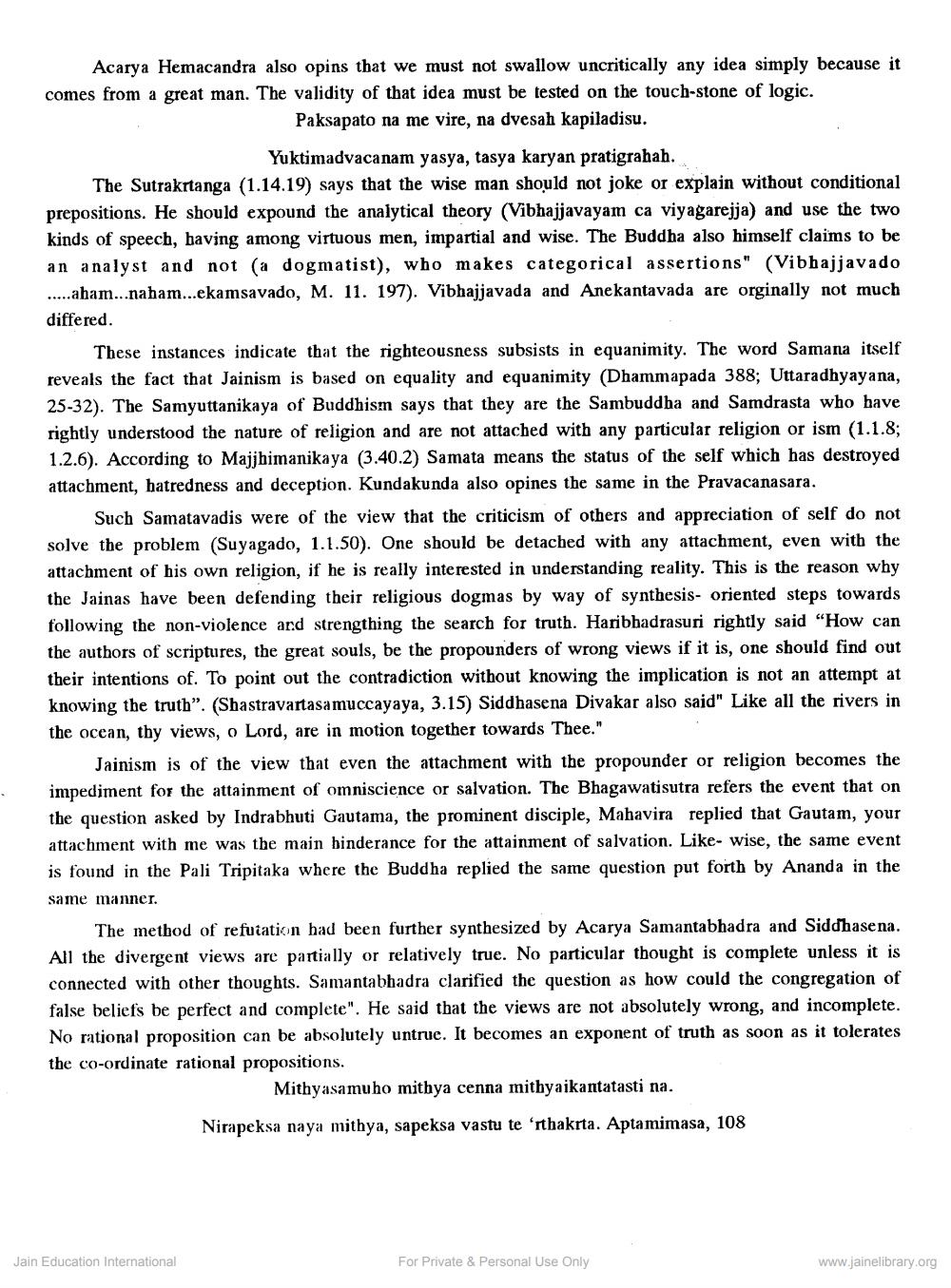________________
Acarya Hemacandra also opins that we must not swallow uncritically any idea simply because it comes from a great man. The validity of that idea must be tested on the touch-stone of logic.
Paksapato na me vire, na dvesah kapiladisu.
Yuktimadvacanam yasya, tasya karyan pratigrahah. The Sutrakrtanga (1.14.19) says that the wise man should not joke or explain without conditional prepositions. He should expound the analytical theory (Vibhajjavayam ca viyagarejja) and use the two kinds of speech, having among virtuous men, impartial and wise. The Buddha also himself claims to be an analyst and not (a dogmatist), who makes categorical assertions" (Vibhajjavado .....aham...naham...ekamsavado, M. 11. 197). Vibhajjavada and Anekantavada are orginally not much differed.
These instances indicate that the righteousness subsists in equanimity. The word Samana itself reveals the fact that Jainism is based on equality and equanimity (Dhammapada 388; Uttaradhyayana, 25-32). The Samyuttanikaya of Buddhism says that they are the Sambuddha and Samdrasta who have rightly understood the nature of religion and are not attached with any particular religion or ism (1.1.8; 1.2.6). According to Majjhimanikaya (3.40.2) Samata means the status of the self which has destroyed attachment, hatredness and deception. Kundakunda also opines the same in the Pravacanasara.
Such Samatavadis were of the view that the criticism of others and appreciation of self do not solve the problem (Suyagado, 1.1.50). One should be detached with any attachment, even with the attachment of his own religion, if he is really interested in understanding reality. This is the reason why the Jainas have been defending their religious dogmas by way of synthesis- oriented steps towards following the non-violence and strengthing the search for truth. Haribhadrasuri rightly said "How can the authors of scriptures, the great souls, be the propounders of wrong views if it is, one should find out their intentions of. To point out the contradiction without knowing the implication is not an attempt at knowing the truth”. (Shastravartasamuccayaya, 3.15) Siddhasena Divakar also said" Like all the rivers in the ocean, thy views, o Lord, are in motion together towards Thee."
Jainism is of the view that even the attachment with the propounder or religion becomes the impediment for the attainment of omniscience or salvation. The Bhagawatisutra refers the event that on the question asked by Indrabhuti Gautama, the prominent disciple, Mahavira replied that Gautam, your attachment with me was the main binderance for the attainment of salvation. Like- wise, the same event is found in the Pali Tripitaka where the Buddha replied the same question put forth by Ananda in the same manner.
The method of refutation had been further synthesized by Acarya Samantabhadra and Siddhasena. All the divergent views are partially or relatively true. No particular thought is complete unless it is connected with other thoughts. Samantabhadra clarified the question as how could the congregation of false beliefs be perfect and complete". He said that the views are not absolutely wrong, and incomplete. No rational proposition can be absolutely untrue. It becomes an exponent of truth as soon as it tolerates the co-ordinate rational propositions.
Mithyasamuho mithya cenna mithyaikantatasti na. Nirapeksa naya mithya, sapeksa vastu te ‘rthakrta. Aptamimasa, 108
Jain Education International
For Private & Personal Use Only
www.jainelibrary.org




